Frank Auerbach, British-German painter, dies at 93
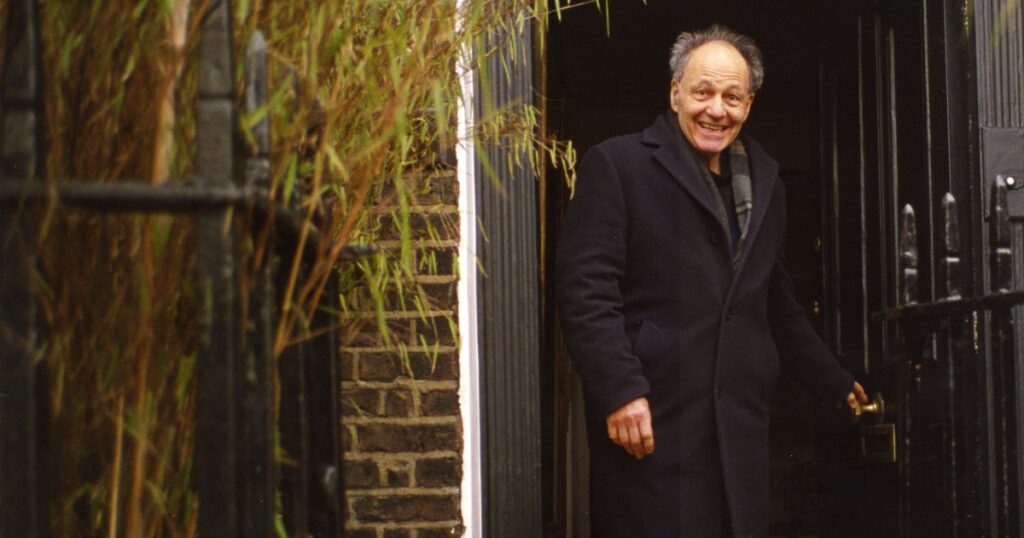
Auerbach came to England in 1939 as a child refugee after fleeing from Nazi Germany. Painter Frank Auerbach, who fled Nazi Germany to Britain as a child, has died at age 93, his representatives say. One of the foremost painters of the 20th century, Auerbach died at his home in London on Monday. Geoffrey Parton, director of Frankie Rossi Art Projects, said on Tuesday that they had lost “a dear friend and remarkable artist but take comfort knowing his voice will resonate for generations to come”. Born in Berlin in 1931, Auerbach came to England in 1939 as a refugee during World War II under the Kindertransport scheme, which rescued mainly Jewish children from Nazi territory. His engineer father and his mother, who trained as an artist, were both killed in the Auschwitz concentration camp. He studied at the St Martin’s School of Art and the Royal College of Art in London and devoted his life to painting, becoming one of the foremost artists of the 20th century. His gallery said the British-German painter lived and worked in the same north London studio from 1954 until his death. Alongside the other “School of London” post-war artists – including Francis Bacon, Lucian Freud and Leon Kossoff – Auerbach focused on figurative paintings regardless of the changing artistic fashions, often slathering canvases in thick layers of paint to produce near-abstract but recognisable landscapes. Auerbach told The Guardian in an interview that he estimated 95 percent of his paint ended up in the bin. “I’m trying to find a new way to express something,” he said, adding, “So I rehearse all the other ways until I surprise myself with something I haven’t previously considered.” In 1986, he represented Britain at the Venice Biennale and won the Golden Lion top prize. In later life, his work was valued at high prices, including in 2023 when his painting Mornington Crescent, inspired by the streets in Camden, north London, near his home, sold at Sotheby’s auction house for $7.1m, a record for the artist. His most recent exhibition, Frank Auerbach: The Charcoal Heads, opened in February at London’s Courtauld Gallery. The artist is survived by his son, Jacob Auerbach. Adblock test (Why?)
Biden (maybe) wants Israel to stop using US bulldozers for ethnic cleansing
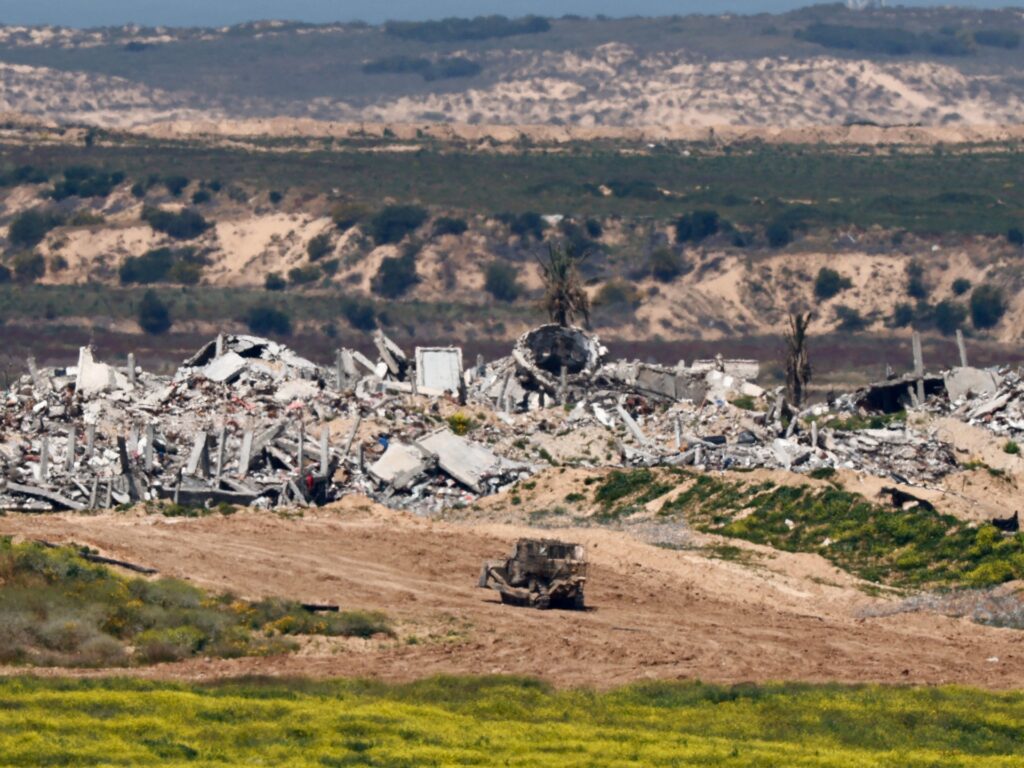
On Sunday, Israeli media reported a freeze in certain bulldozer shipments from the United States to Israel. The prominent English-language website Ynet News, for example, went with the sensational headline: “D9 bulldozer shipment stalled by US embargo, leaving Israeli soldiers exposed.” To be sure, there is nothing more tragic than “exposed” soldiers belonging to a genocidal army. According to the article, 134 bulldozers “ordered and paid for” by the Israeli military are currently “awaiting export approval from the US State Department” but their shipment has been stymied by internal US opposition and an apparent decision by President Joe Biden’s administration to freeze deliveries “for several months”. The D9 model is manufactured by the US firm Caterpillar Inc. Some observers have taken this move to mean that the Bidenites are registering their displeasure with the Israeli war crime of ethnic cleansing. But if you’re going to be against ethnic cleansing, why not go all the way and be against genocide too? Indeed, a shortage of new bulldozers will have precisely zero bearing on Israel’s ability to continue waging genocide in Gaza, where officially more than 43,000 Palestinians have been slaughtered over the past 13 months but the real death toll is undoubtedly many times higher. Ynet noted that the machines are used “primarily for flattening structures in the Gaza Strip” but they are “also needed” in southern Lebanon, where Israel’s latest terrorist operations have also killed thousands. The Israeli army’s existing arsenal of D9 dozers is reportedly in need of maintenance, hence the replacement order – the moratorium on delivery of which “will likely delay another significant operation by [Israel’s military] that remains incomplete: establishing a one-kilometer-wide [0.6-mile-wide] buffer zone between the Gaza Strip [and Israel] involving the leveling of hundreds of Palestinian buildings and agricultural lands”. Not only is there the troubling issue of the “exposed” soldiers then; there is also the annoying interruption to Israel’s scorched-earth plan. In addition to “leveling” civilian infrastructure and wiping out agriculture, bulldozers have served other handy purposes in Gaza. There was that time in September, for instance, that the Palestinian Centre for Human Rights documented the shooting by Israeli soldiers of 17-year-old Majed Fida Abu Zina, a resident of Gaza’s Far’a refugee camp, who was “left to bleed for approximately an hour and a half”, after which the Israeli army “brought in a bulldozer and began desecrating the boy’s body, tearing open his abdomen and exposing his internal organs before dragging and throwing him on al-Far’a hill”. Incidentally, Israel’s bulldozing of human beings has not been restricted to Palestinians. In 2003, 23-year-old American peace activist Rachel Corrie was crushed to death by a 36-tonne Caterpillar bulldozer driven by an Israeli soldier in the Gaza Strip city of Rafah, where she was protesting against Israel’s demolition of Palestinian homes. Call it Caterpillateral damage. And Rafah, as it so happens, was central to the story the last time the Biden administration made noises about suspending shipments of lethal materials to Israel. In May, Biden announced he would no longer be supplying offensive weapons to the Israeli army in the event of an all-out assault on the southern Gaza city, reasoning that “civilians have been killed in Gaza as a consequence of those bombs.” Well, yeah – that’s how genocide works. And suspending a couple of bomb shipments here and there ultimately does absolutely nothing to put a dent in mass killings. Ditto for denying the Israelis their D9 dozer replacements. These extremely isolated cases of moratoria on weapons transfers impact Israeli military behaviour even less given that they are accompanied by a continuous flood of billions upon billions of dollars in US military aid to Israel and other free-flowing weaponry. Recall that in April, just weeks before Biden issued his warning re: Rafah, the US Congress OK’d no less than $26bn in supplemental wartime aid to Israel – which was authorised on top of all of the billions of dollars Israel already receives annually from its trusty American partner in crime. And as Al Jazeera reported in August, the Biden administration had just “approved sending $20bn worth of arms to Israel, even as the US publicly calls for restraint in the war on Gaza”. Of course, the mixed messaging is fully exploited by Israel’s psychopathic government, headed by Prime Minister Benjamin Netanyahu, which invokes every perceived slight by the fundamentally obsequious US as alleged evidence that even Israel’s best friends are somehow now anti-Israel. As per the Ynet dispatch, the temporary freeze in D9 bulldozer shipments is simply another case of Israel getting the “cold shoulder… from Washington” – a state of affairs that “could pose a risk to [Israeli] soldiers” in both the Gaza Strip and Lebanon. And yet the “cold shoulder” has not and will not prevent Israel from literally and metaphorically bulldozing Gaza to death while raining made-in-the-USA apocalyptic destruction from the sky. Forget the Israeli soldiers left “exposed” by the reported US freeze on bulldozer shipments. The population of Gaza is fully exposed to genocide – and international opposition to this most sinister reality is being bulldozed as we speak. The views expressed in this article are the author’s own and do not necessarily reflect Al Jazeera’s editorial stance. Adblock test (Why?)
Opposition secures landslide victory in Mauritius election
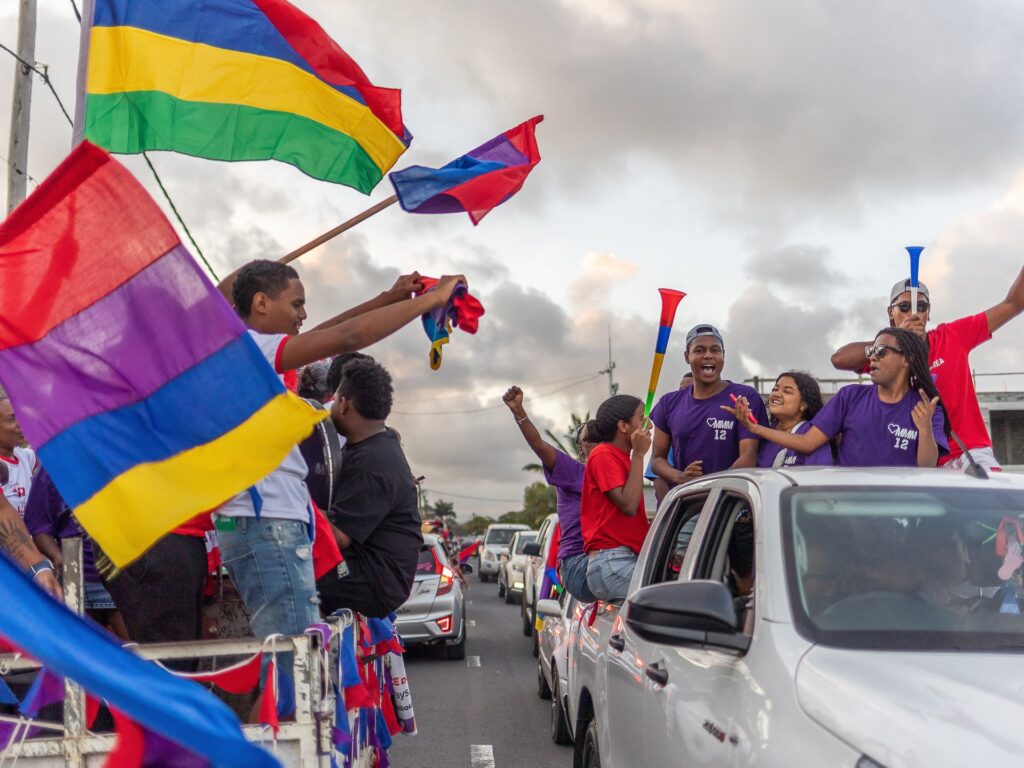
Former prime minister Navin Ramgoolam has won a third term in the Indian Ocean nation, official results show. Opposition leader Navin Ramgoolam has won a landslide victory in Mauritius’s parliamentary vote, the election commission said. The Office of the Electoral Commissioner said on Tuesday that Rangoolam and his Alliance of Change (ADC) coalition won 62.6 percent of the vote, securing the three-time former prime minister a fourth term. The ADC won 60 of 62 seats in the National Assembly, state broadcaster Mauritius Broadcasting Corporation reported. “The court of the people has delivered its verdict and a new Mauritius awakes,” 77-year-old Rangoolam said to crowds of supporters amid boisterous cheers and blaring horns. Ramgoolam served as prime minister from 1995 to 2000 and again from 2005 to 2014. As well as the 60 seats for Mauritius, there were two up for grabs for the island of Rodrigues and another eight allocated under what is dubbed the “best loser” system. The winner-takes-all election model means single coalitions often dominate parliament. ‘Free to talk’ Incumbent Prime Minister Pravind Jugnauth had conceded on Monday that his Lepep alliance, led by his Militant Socialist Movement (MSM), was “heading towards a huge defeat”. “The people have chosen another team to lead the country,” Jugnauth, who has served as prime minister since 2017, told reporters. Only last month, the 62-year-old prime minister was celebrating a historic deal that saw Britain cede sovereignty over the Chagos Islands to Mauritius after a long-running dispute. But the vote was overshadowed by an explosive wire-tapping scandal, when secretly recorded phone calls of politicians, diplomats, members of civil society and journalists were leaked online. Ramgoolam said that following his landslide victory, he would first dismantle the country’s “spying system so that Mauritians will be free to talk”. Economic challenges During the campaign, both camps promised to improve the lot of Mauritians who face cost-of-living difficulties despite robust economic growth. Measures outlined in the Alliance of Change manifesto include the creation of a fund to support families facing hardship, free public transport, increased pensions and reduced fuel prices, as well as efforts to tackle corruption and boost the green economy. It also called for constitutional and electoral reforms including changing how the president and parliament speaker are chosen. At least one million people were registered to vote on Sunday in the 12th election since Mauritius gained independence from the United Kingdom in 1968. Mauritius, which sits about 2,000km (1,240 miles) off Africa’s east coast, is recognised as one of the continent’s most stable democracies and has developed a successful economy underpinned by its finance, tourism and agricultural sectors since gaining independence. Both Jugnauth and Ramgoolam are members of the dynasties that have dominated the leadership of Mauritius since independence. Ramgoolam, who previously worked as a doctor and a lawyer, is the son of Seewoosagur Ramgoolam, who led Mauritius to independence from Britain. Adblock test (Why?)
In Australia’s outback, youth crime stymies efforts to get tourism on track
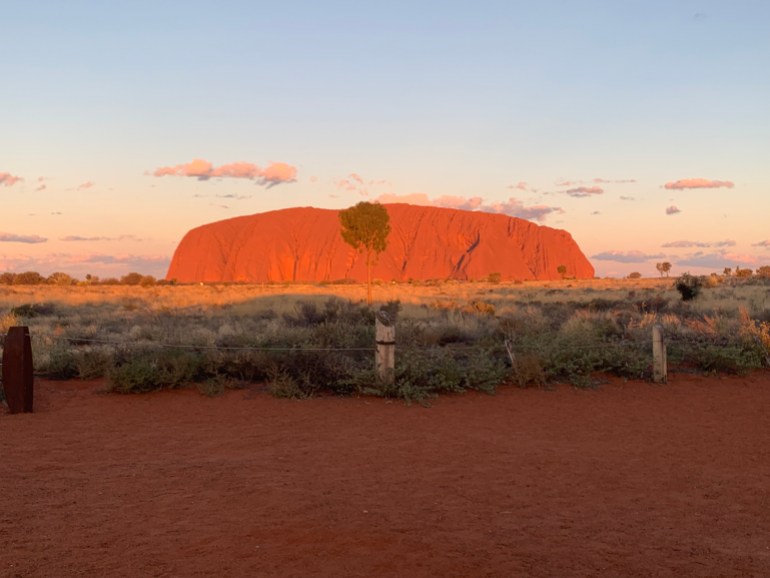
Alice Springs, Australia – For Ben Hall, the CEO of tour bus operator AAT Kings, business lately has been tough. He says visitors are not booking tours to Uluru, a huge sandstone monolith that is the most famous attraction in Australia’s vast Northern Territory, in the numbers they used to. “We’ve certainly seen the trips from Alice Springs to Uluru have been a little bit softer,” Hall, who operates a fleet of about 30 buses focusing on tours to Uluru, told Al Jazeera. “We’ve added a couple of new short break itineraries for this year into the region…but certainly it’s been tough trading.” Tour and car rental companies across Australia’s Red Centre, as the country’s vast outback region is often called, have reported a similar drop-off in business. While tourism operators attribute the decline to a number of factors, most agree that part of the cause is escalating youth crime in Alice Springs, a remote town of some 40,000 people that serves as a base for visitors to outback attractions such as Uluru. In the past two years, youth crime in the town has captured national media attention and stoked political turmoil at the both federal and state government levels, even though crimes by minors have also risen nationwide. Prime Minister Anthony Albanese, who leads the centre-left Labor Party, has made several visits to the town to highlight his government’s efforts to tackle the issue. In March, and again in July, the Northern Territory government implemented curfews banning minors from the town centre at night following a series of violent attacks. Uluru is a major attraction in the Northern Territory [Wing Kuang/Al Jazeera] The rise in crime has drawn particular attention to Alice Springs in the media as it came after the Northern Territory government ended a 15-year alcohol ban in remote Aboriginal communities in late 2022. In 2007, Australia’s federal government implemented a series of interventions in the Northern Territory, where about one-third of the population is Indigenous, in response to a territory government report that found evidence of widespread child sexual abuse in remote Aboriginal communities. The federal interventions, which some rights groups criticised as racist and discriminatory, included a blanket ban on alcohol in remote Aboriginal communities that was extended by successive territory governments. After the alcohol ban was lifted, a series of high-profile violent incidents in Alice Springs, including teenagers stealing vehicles and attacking police cars, made headlines across the country. In the year ending November 2023, violent offences by youths rose to 1,182, a 50 percent rise compared to 2019-20, according to the Northern Territory’s Department of the Attorney-General and Justice. After accounting for population change, the overall youth offender rate decreased from 2,855 to 2,819 offenders per 100,000 persons in 2022–23, according to the Australian Bureau of Statistics, although part of that decrease can be explained by the government’s decision in August 2023 to raise the age of criminal responsibility from 10 to 12. Local police warned residents to avoid visiting the town centre, and the Northern Territory government reintroduced a ban on alcohol sales in January 2023. While the uptick in crime has prompted politicians to action, some community leaders and legal experts have criticised the territory government for implementing “draconian” policies, such as curfews, that could further stigmatise Indigenous communities. Human rights groups have also accused police of targeting Indigenous people in the territory, which has one of the highest rates of incarceration in the world. Last month, the newly elected Northern Territory government lowered the age of criminal responsibility from 12 to 10, prompting concern among community leaders that Indigenous teenagers will be locked up at even higher rates. North Australian Aboriginal Justice Agency, a not-for-profit legal service, noted that between 2018 and 2023, the number of prisoners in the territory rose 22 percent, which it claimed was a result of young Aboriginal people being targeted by law enforcement. Jared Sharp, a legal officer for the non-profit, said in a press release that while the public perceives a rise in youth crime in the Northern Territory, “youth justice court lodgements territory-wide have fallen for three years running”. The focus on youth crime and subsequent crackdown have been keenly felt by tourism operators, who typically see an uptick in tourism during the dry season between April and October. In April, tourism industry figures called for “urgent” financial support from the government after the announcement of the first curfew prompted a wave of customer cancellations. In September, Ross River Resort, a popular stop for travellers en route to Alice Springs, announced that it would close its doors to the general public from the following month. Martin Ansell, co-director of resort operator Grollo Group, told the Australian Broadcasting Corporation that tourism had dropped “50 to 60 per cent” from the previous year. Kirsten Holmgren, who runs tours of the East MacDonnell Ranges, said she has had a “very, very quiet” season. “This year I haven’t had more than six people on a 16-seater bus, so I do have to fill in between working for other companies,” Holmgren told Al Jazeera. Kirsten Holmgren says her customers have sharply declined [Wing Kuang/Al Jazeera] While Holmgren acknowledges the issue of youth crime in Alice Springs, she believes the media have given the issue outsized attention, discouraging visitors. “So break-ins and car thefts have definitely been on the rise. This in no way affects tourism at all. It only affects the locals,” Holmgren said. Danial Rochford, CEO of Tourism Central Australia, said crime is not the only reason tourism has been suffering, pointing to cost-of-living pressures as well as reduced flights to Alice Springs. Tourism in the region “has come under enormous challenge”, Rochford told Al Jazeera. While tour companies have reported a drop-off in visitors passing through or basing themselves in Alice Springs and its surrounds, operators are more sanguine about the number of visitors to Uluru itself. A spokesperson for Voyages Indigenous Tourism Australia, an Indigenous-owned business that runs the local Ayers Rock Resort, said
New Zealand’s Luxon apologises to victims of abuse in state and church care
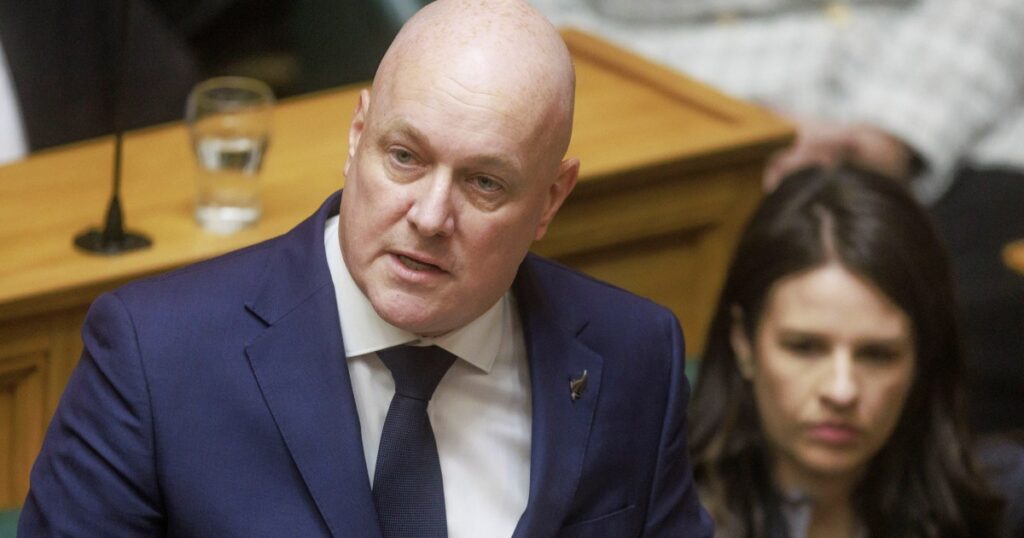
New Zealand Prime Minister says government must take responsibility for ‘horrific’ abuse of some 200,000 people in care. New Zealand Prime Minister Christopher Luxon has issued a landmark apology to survivors of abuse in state and church care. “It was horrific. It was heartbreaking. It was wrong. And it should never have happened,” Luxon said on Tuesday in remarks to parliament. “For many of you, it changed the course of your life, and for that, the government must take responsibility.” The rare apology comes after an independent inquiry in July reported its finding that New Zealand’s state and faith-based institutions had presided over the abuse of some 200,000 children, young people and vulnerable adults over the span of seven decades. New Zealand’s Royal Commission of Inquiry into Abuse in Care found that nearly one in three people in state or religious care between 1950 and 2019 experienced abuse in what amounted to a “national disgrace”. Sexual abuse was “commonplace”, while physical abuse was “prevalent across all settings”, the inquiry found, with some staff going to “extremes to inflict as much pain as possible using weapons and electric shocks”. The inquiry also found that Maori and Pacific Islander people were targeted because of their ethnicity, such as by being prevented from engaging with their cultural heritage and practices. The inquiry made 138 recommendations, including calling for public apologies from New Zealand’s government and the heads of the Catholic and Anglican churches. Other recommendations included legislative changes to make it easier to hold abusers accountable and the establishment of a Ministry for the Care System that would be independent from other government agencies involved in the care system. “You deserved so much better. And I am deeply sorry that New Zealand did not do better by you,” Luxon said. “I am sorry you were not believed when you came forward to report your abuse. I am sorry that many bystanders – staff, volunteers and carers – turned a blind eye and failed to stop or report abuse.” Adblock test (Why?)
US military says strikes in Syria targeted ‘Iranian backed groups’
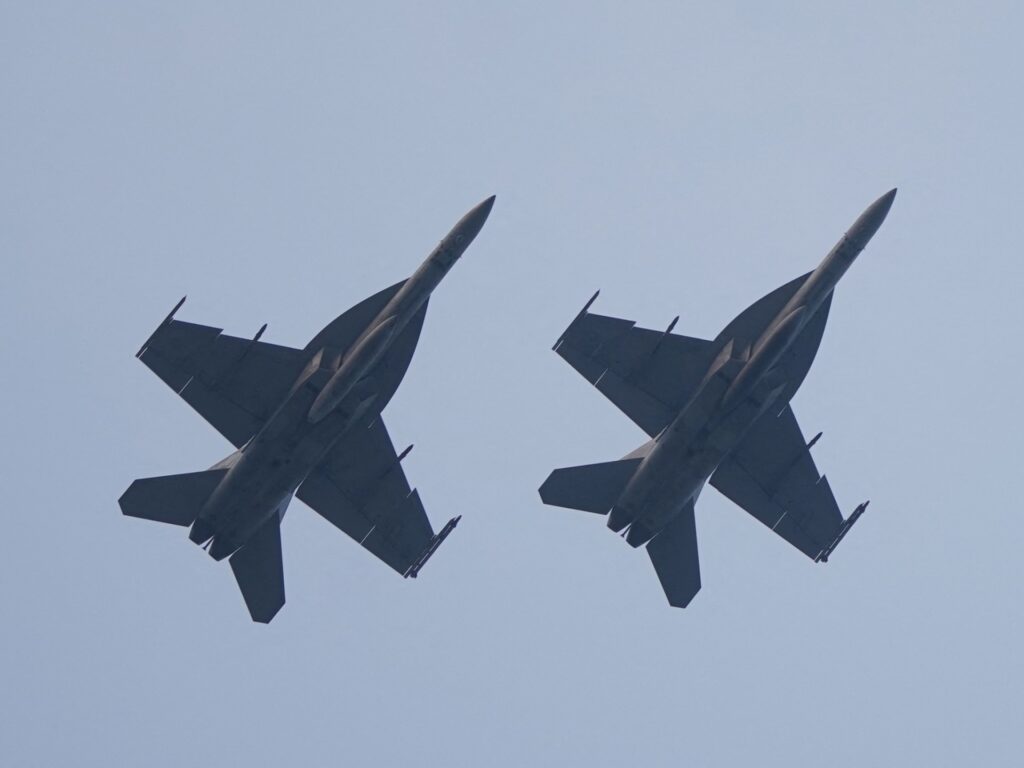
US Central Command said nine targets were hit at two locations in Syria in response to an attack on US forces over the previous 24 hours. The US military has carried out strikes against targets in Syria in what the United States Central Command (CENTCOM) said was a response to recent attacks on US forces by “Iranian-aligned targets” in the country. CENTCOM’s commander General Michael Erik Kurilla said in a statement early on Tuesday that the US military action sent a “clear” message to armed groups backed by Iran and operating in Syria. “Attacks against US and coalition partners in the region will not be tolerated,” Kurilla said, describing attacks on US military personnel in Syria over the past 24 hours as “reckless”. “These strikes will degrade the Iranian-backed groups’ ability to plan and launch future attacks,” CENTCOM said, adding that nine targets in two locations were hit in the US attacks. The US has about 900 soldiers based in the eastern part of Syria and 2,500 more in neighbouring Iraq, whose stated mission is to advise and assist local forces battling to prevent a resurgence of the group known as ISIL (ISIS), which in 2014 seized large swaths of both Syria and Iraq but was later defeated in fierce fighting. No US personnel were reported injured in the attacks that CENTCOM said had been carried out over the previous 24 hours by Iranian-backed groups. The US military also did not specify which armed groups were targeted in Syria or whether the strikes were thought to have resulted in casualties. pic.twitter.com/Hnw4dW6LEe — U.S. Central Command (@CENTCOM) November 11, 2024 United Kingdom-based monitoring group the Syrian Observatory for Human Rights reported that four Syrian members of Iranian-backed armed groups were killed on Monday and 10 others were severely injured when fighter jets of the “international coalition” attacked a “headquarters” in the Al Mayadeen area of eastern Syria’s Deir Az Zor countryside. Syria state media reported earlier on Monday that Israel’s Air Force had attacked an aid convoy in the Shamsin area, located approximately 20km (12 miles) from the border with Lebanon, forcing the closure of Syria’s main north-south highway that links the capital, Damascus, with the northern city of Aleppo. There were no immediate reports of casualties and state television did not provide details about the convoy that was attacked, though the area is known as a gathering point for refugees fleeing from Israeli attacks on Lebanon. On Sunday, an Israeli air strike also hit a residential building in the Damascus suburb of Sayyida Zeinab, killing seven civilians, including women and children, the Syrian Arab News Agency (SANA) reported. Twenty others were wounded in the attack, SANA said. Israel has carried out hundreds of strikes in Syria in recent years but rarely acknowledges the attacks on its neighbour, which it claims target Iranian-supported armed groups that threaten Israel’s security. Adblock test (Why?)
Video: Palestinian woman creates clothes from blankets in Gaza

NewsFeed University professor Nidaa Aitta creates affordable winter clothing for displaced Palestinians by recycling blankets in Gaza, where Israel’s restrictions have stopped ready-made clothes coming in and have sent prices soaring. Adblock test (Why?)
Iran’s Axis of Resistance explained | Start Here

The Axis of Resistance is a network of groups that have been a key part of Iran’s defence strategy for years. But we’ve now seen Israel and Iran attack each other directly, while Israel has invaded Lebanon to go after the biggest group in the axis, Hezbollah. So what does this mean for the balance of power in the region, and where does the Axis of Resistance fit into it now? #AJStartHere with Sandra Gathmann explains. This episode features: Barbara Slavin | Distinguished fellow, Stimson Center Dina Esfandiary | Senior adviser, MENA Program, International Crisis Group Mohammad Marandi | Professor of English Literature and Orientalism, University of Tehran Randa Slim | Senior fellow, Middle East Institute Ali Vaez | Iran project director, International Crisis Group Abas Aslani | Senior research fellow, Center for Middle East Strategic Studies Adblock test (Why?)
Israeli attack in Gaza siege zone kills 36 members of same family

NewsFeed “Noor, the love of Dad and Mum.” A Palestinian girl who wrote a message on her arm so she could be identified was one of 36 members of the same family killed in an Israeli air attack in north Gaza. Published On 11 Nov 202411 Nov 2024 Adblock test (Why?)
Canada remembers Murray Sinclair, trailblazing Indigenous judge and senator
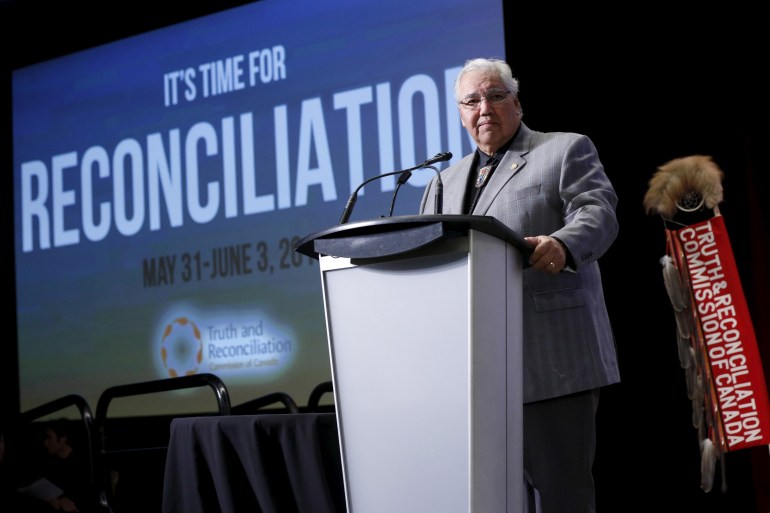
Relatives, friends and leaders say Sinclair, who died this week aged 73, and his legacy will ‘never be forgotten’. Canada has held a national memorial for Murray Sinclair, a trailblazing Indigenous judge and senator who led the country’s Truth and Reconciliation Commission into abuses committed against Indigenous children at residential schools. The public event on Sunday afternoon in Winnipeg, in central Canada, came days after Sinclair passed away on November 4 at age 73. “Few people have shaped this country in the way that my father has, and few people can say they changed the course of this country the way that my father had – to put us on a better path,” his son Niigaan Sinclair said at the start of the memorial. “All of us: Indigenous, Canadians, newcomers, every person whether you are new to this place or whether you have been here since time immemorial, from the beginning, all of us have been touched by him in some way.” Sinclair, an Anishinaabe lawyer and senator and a member of the Peguis First Nation, was the first Indigenous judge in Manitoba and the second-ever in Canada. As chief commissioner of the Truth and Reconciliation Commission (TRC), Sinclair organised hundreds of hearings across Canada to hear directly from survivors of the country’s residential school system. Caring Society statement on the Passing of the Honourable Murray Sinclair. pic.twitter.com/inhhyamNKt — First Nations Child & Family Caring Society (@CaringSociety) November 4, 2024 From the late 1800s until 1996, Canada forcibly removed an estimated 150,000 Indigenous children from their families and forced them to attend the institutions. They were made to cut their hair, forbidden from speaking their native language, and many were physically and sexually abused. “The residential school system established for Canada’s Indigenous population in the nineteenth century is one of the darkest, most troubling chapters in our nation’s history,” Sinclair wrote in the TRC’s final report. “It is clear that residential schools were a key component of a Canadian government policy of cultural genocide.” Mary Simon, Canada’s first Indigenous governor general, described Sinclair during Sunday’s memorial as “the voice of truth, justice and healing”. She said he had “a heart brave enough to expose injustices, yet generous enough to make everyone around him feel welcome and important”. Other Indigenous community leaders and advocates across Canada also have spent the past week remembering Sinclair for his unwavering commitment to confronting the systemic racism faced by Indigenous people. “One of the greatest insights he shared is that reconciliation is not a task to be done by Survivors. True reconciliation, he said, must include institutional change,” Alvin Fiddler, grand chief of Nishnawbe Aski Nation (NAN) in northern Ontario, said in a statement after Sinclair’s death. Sinclair speaks at a Truth and Reconciliation Commission of Canada event in 2015 [Blair Gable/Reuters] “Reconciliation, he taught us, is ours to achieve,” Fiddler said. “The work ahead of us is difficult, but we share his belief that we owe it to each other to build a country based on a shared future of healing and trust. Murray encouraged us to walk the path towards reconciliation. Accepting this responsibility is a fitting way to honour his legacy.” Pam Palmater, chair of Indigenous governance at Toronto Metropolitan University, said Sinclair was someone who “never stopped educating Canadians … and making sure we never forget”. In an interview with CBC News on Sunday, Palmater noted that Sinclair “didn’t just conduct the TRC”; he was involved in many other initiatives, including an inquiry into child deaths in Manitoba and an investigation into the police department in Thunder Bay, Ontario. “He’s never going to be forgotten. He’s one of those people where his legacy lives on,” Palmater said. “His impact is going to be felt for many decades to come.” Adblock test (Why?)
